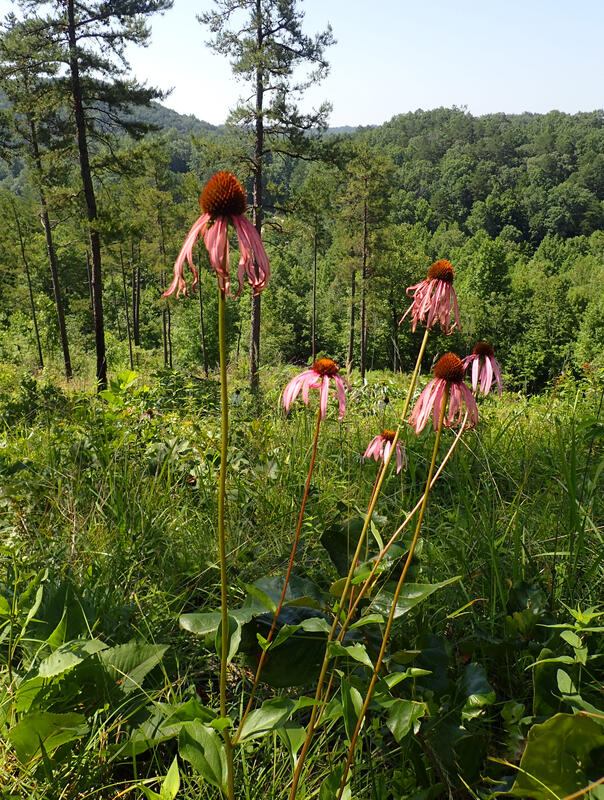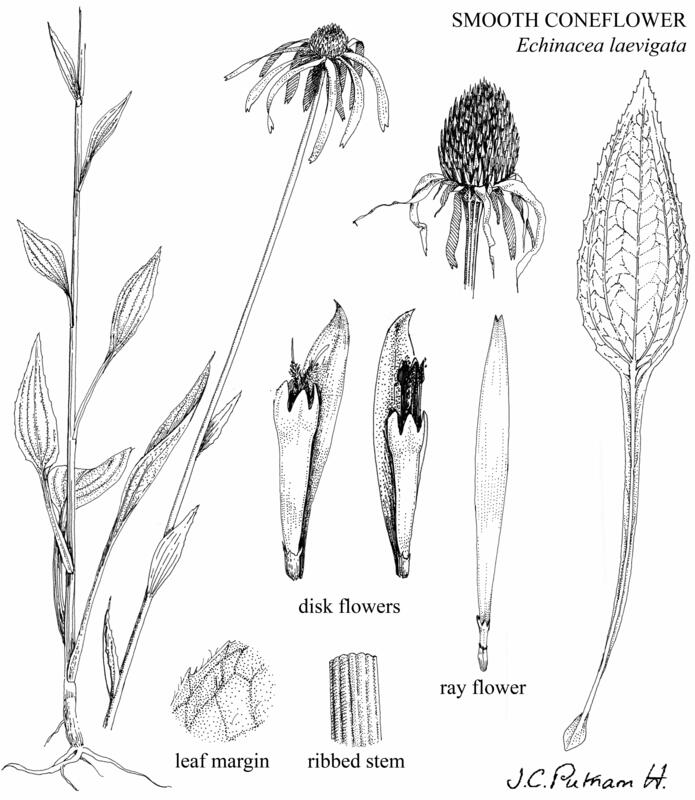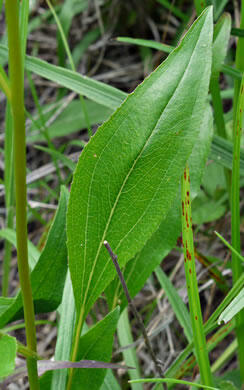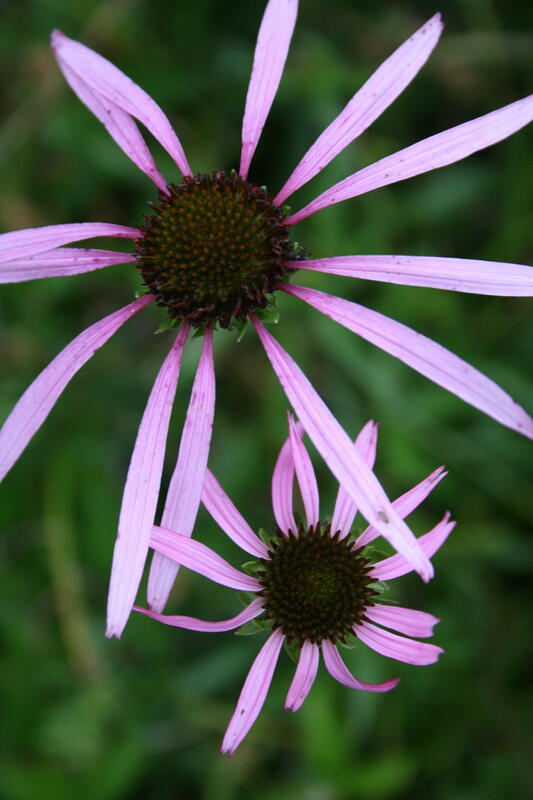







Loading profile. Please wait . . .
Echinacea laevigata (C.L. Boynt. & Beadle) Blake
Smooth Purple Coneflower





Federal Protection: Listed Endangered
State Protection: Endangered
Global Rank: G2G3
State Rank: S2
Element Locations Tracked in Biotics: Yes
SWAP 2015 Species of Greatest Conservation Need (SGCN): Yes
SWAP 2025 Species of Greatest Conservation Need (SGCN): Yes
2025 SGCN Priority Tier: Highest Conservation Concern
Element Occurrences (EOs) in Georgia: 33
Habitat Summary for element in Georgia: Upland forests over amphibolite
Perennial herb with smooth, usually unbranched stems 14 - 43 inches (35 - 110 cm) tall. Basal leaf blades are 4 - 20 inches (10 - 50 cm) inches long and 1 - 2.5 inches (3 - 6.5 cm) wide, with slightly winged, purplish leaf stalks up to 10 inches (26 cm) long; the lower leaf surface are smooth, upper surfaces are smooth or slightly roughened with stiff hairs; the leaf margins have small teeth, especially near the tip. Stem leaves are similar in shape to basal leaves, alternate, widely spaced, and gradually reduced in size up the stem. The flower head is solitary at the top of the stem, with a central, rounded or cone-shaped, disk about 1 inch (3 cm) wide and 1.5 inches (4 cm) high. The disk supports many dark purple disk flowers with yellow pollen and many stiff, sharply pointed bristles (pappi, chaff) with purple, incurving tips. Ray flowers are 1.4 - 3 inches (3.5 - 8 cm) long and 0.1 - 0.28 inch wide (3 - 7 mm) wide, narrowly oblong, pink to pale purple, drooping. Fruit is a dry and seed-like achene about 0.2 inch (4 - 5 mm) long, tan, banded, usually hairless, and 4-sided.
See "Related Rare Species" below.
Pale Purple Coneflower (Echinacea pallida) basal leaves are up to 13 inches (33 cm) long and only 1.6 inches (4 cm) wide and usually very hairy; its pollen grains are usually white, rarely yellow. It occurs in three widely separated counties in northwest and central Georgia in open pine-hardwood woodlands and on roadbanks. It was once thought to be a garden escape in Georgia but is now believed to be native. For more information, see: http://www.missouriplants.com/Pinkalt/Echinacea_pallida_page.html
Purple Coneflower (Echinacea purpurea) is widely planted in gardens but, because it requires basic soils, is rare in the wild in Georgia; it occurs in open woodlands in several northwest counties. Its leaves are oval, rough or hairy on both surfaces, with toothed edges and long leaf stalks; its stems are hairy; the purple ray flowers are 1-3 inches (3-8 cm) long, only slightly drooping; the chaff bristles are orange with straight tips. For more information, see: http://www.missouriplants.com/Pinkalt/Echinacea_purpurea_page.html
Prairie Purple Coneflower (Echinacea simulata) occurs in Coosa Valley prairies in northwest Georgia. For more information, see: https://georgiabiodiversity.org/portal/profile?group=plants&es_id=18578
Grassy openings and rocky glades with shallow soil over mafic bedrock; sunny roadsides and rights-of-way through these habitats. Often with Rattlesnake-master (Eryngium yuccifolium), Sunflowers (Helianthus spp.), Shortleaf Pine (Pinus echinata), Post Oak (Quercus stellata), and Blackjack Oak (Quercus marilandica). Historically, Smooth Coneflower probably occurred in prairies and savannas maintained by Native American burning, large animal grazing and browsing, and lightning-set fires. These openings are now maintained by prescribed fire.
Smooth Coneflower is a perennial herb that reproduces primarily by sexual means via outcrossing and, to a lesser degree, vegetatively by the spread of rhizomes. There are no known specialized pollinators; butterflies, moths, beetles, grasshoppers, bees, wasps, true bugs, and sucking insects (such as cicadas, hoppers, and aphids) have all been seen visiting its flowers. The fruit is an achene which is gravity-dispersed and also possibly dispersed by birds and small mammals. Seeds will germinate in most soil types but seedlings require full sun and open habitat to thrive. Young plants are not strong competitors and are quickly overwhelmed by other more aggressive plants.
Surveys are best conducted during flowering (mid-May–July) and fruiting (July–October).
Currently known from Georgia, South Carolina, North Carolina, and Virginia, this species was once also found in Pennsylvania and Maryland.
Destruction of habitat by conversion to pine plantations, residential and commercial developments, and utility and highway rights-of-way; fire suppression in prairie habitats; use of herbicides in rights-of-way; and poaching.
| Threat 1 | Threat 2 | Threat 3 | |
|---|---|---|---|
| General Threat | Natural system modifications | Natural system modifications | Invasive & other problematic species, genes & diseases |
| Specific Threat | None | None | None |
Echinacea laevigata is ranked S2 by the Georgia Department of Natural Resources, indicating that the species is imperiled in Georgia. It is listed as Endangered by the State of Georgia and the U.S. Fish and Wildlife Service. Approximately 25 sites comprising 3 populations are known, most in the Chattahoochee National Forest. Five conservation outplantings have also been established in the National Forest.
Use hand-clearing or prescribed fire to restore open habitats. Avoid mechanical clearing and logging. Protect roadside and right-of-way populations from herbicides and poorly timed mowing. Monitor outplantings for recruitment.
Alley, H. 2002. Experimental reintroduction of the endangered Echinacea laevigata: comparison of planting methods and effects of light intensity on biomass and photosynthesis. M.S. Thesis, University of Georgia, Athens. https://getd.libs.uga.edu/pdfs/alley_heather_j_200205_ms.pdf
Alley, H. and J.M. Affolter. 2004. Experimental comparison of reintroduction methods for the endangered Echinacea laevigata (Boynton and Beadle) Blake. Natural Areas Journal 24(4): 345-350. https://www.jstor.org/stable/43912347?seq=1#metadata_info_tab_contents
Apsit, V.J. and P.M. Dixon. 2001. Genetic diversity and population structure in Echinacea laevigata (Boynton and Beadle) Blake, an endangered plant species. Natural Areas Journal 21(1): 71-77. https://www.jstor.org/stable/43911969?seq=1#metadata_info_tab_contents
Binns, S.E., B.R. Baum, and J.T. Arnason. 2002. Taxonomic revision of Echinacea (Asteraceae: Heliantheae). Systematic Botany 27(3): 610-632. https://bioone.org/journals/Systematic-Botany/volume-27/issue-3/0363-6445-27.3.610/A-Taxonomic-Revision-of-Echinacea-Asteraceae-Heliantheae/10.1043/0363-6445-27.3.610.full
Chafin, L.G. 2007. Field guide to the rare plants of Georgia. State Botanical Garden of Georgia and University of Georgia Press, Athens.
Cronquist, A. 1980. Vascular flora of the southeastern United States, Vol. 1, Asteraceae. University of North Carolina Press, Chapel Hill.
Gadd, L.E. 2006. Pollination biology of the federally endangered Echinacea laevigata (Boynton and Beadle) Blake, smooth coneflower, in small, isolated populations. M.S. Thesis, North Carolina State University, Raleigh. http://repository.lib.ncsu.edu/ir/bitstream/1840.16/1884/1/etd.pdf
Kral, R. 1983. A report on some rare, threatened, or endangered forest-related vascular plants of the South. Technical Publication R8-TP2. United States Forest Service, Atlanta.
McGregor, R.L. 1968. Taxonomy of the genus Echinacea (Compositae). University of Kansas Science Bulletin 48(4): 113-142. https://ci.nii.ac.jp/naid/10007685123/
McKeown, K.A. 1999. Review of the taxonomy of the genus Echinacea. In: J. Janick, Perspectives on new crops and new uses. ASHS Press, Alexandria, Virginia. https://www.hort.purdue.edu/newcrop/proceedings1999/pdf/mckeown.pdf
NatureServe. 2020. Echinacea laevigata species account. NatureServe Explorer. Arlington, Virginia. https://explorer.natureserve.org/Taxon/ELEMENT_GLOBAL.2.147692/Echinacea_laevigata
Patrick, T.S., J.R. Allison, and G.A. Krakow. 1995. Protected plants of Georgia. Georgia Department of Natural Resources, Natural Heritage Program, Social Circle.
Urbatsch, L.E., K.M. Neubig, and P.B. Cox. 2006. Flora of North America, Vol. 21. Oxford University Press, New York. http://beta.floranorthamerica.org/Echinacea_laevigata
USFWS. 2018. Smooth coneflower (Echinacea laevigata) species accounts and related documents. U.S. Fish and Wildlife Service, Washington D.C. https://ecos.fws.gov/ecp0/profile/speciesProfile?sId=3473
Weakley, A.S. 2015. Flora of the southern and mid-Atlantic States. University of North Carolina Herbarium, University of North Carolina, Chapel Hill. http://www.herbarium.unc.edu/flora.htm
Linda G. Chafin
L. Chafin, Feb. 2007: original account
K. Owers, Jan. 2010: added pictures
G. Krakow, Apr. 2016: updated links
L. Chafin, Jun 2020: updated original account.



